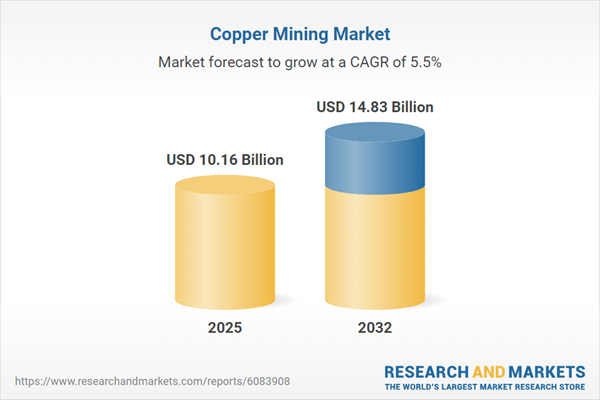Speak directly to the analyst to clarify any post sales queries you may have.
The copper mining market is navigating rapid transformation, shaped by shifting geopolitical influences, mounting sustainability targets, and advances in digital technologies. As the sector evolves, decision-makers must balance operational efficiency with forward-looking strategies in a landscape increasingly defined by regulatory and stakeholder expectations.
Market Snapshot: Global Copper Mining Market Size and Growth Trajectory
The Copper Mining Market has grown from USD 9.64 billion in 2024 to USD 10.16 billion in 2025, with continued expansion at a CAGR of 5.52% projected to reach USD 14.83 billion by 2032. This growth is underpinned by robust demand from sectors investing in decarbonization, electrification, and critical infrastructure renewal, as well as increased requirements for copper in industrial and developed economies. Industry leaders increasingly prioritize resilience and supply security across the value chain to capture opportunity in this evolving environment.
Scope & Segmentation Analysis
This report delivers a strategic, multidimensional analysis tailored for senior industry executives and investors, encompassing:
- Mining Methods: Coverage includes open pit mining (such as conventional drilling and strip mining) and underground mining (notably block caving and cut and fill methods) to account for operational and cost variations.
- Ore Types: Examination of copper extracted from oxide ores (azurite, malachite, tenorite) alongside sulfide ores (bornite, chalcocite, chalcopyrite), reflecting process efficiency and end-use distinctions.
- Distribution Channels: Analysis of established supply routes including dealers (global and domestic), direct sales to end users, and emerging online sales platforms.
- Product Forms: Insights into market trends for copper cathodes (high purity and standard), granules, rods, and various wire types for industrial and electrical applications.
- Applications: Sector breakdowns span construction (including plumbing and roofing), electrical wiring, electronics (PCB and semiconductor manufacturing), and industrial machinery demand drivers.
- Regional Coverage: Evaluation extends across the Americas (with in-depth focus on North and Latin America), Europe, the Middle East & Africa, and Asia-Pacific markets such as China, India, Japan, and Australia, highlighting unique market drivers within each geography.
The segmentation framework contextualizes technology adoption levels and the influence of shifting end-user requirements in optimizing operational and commercial outcomes for each segment.
Copper Mining Market: Key Takeaways for Strategic Leadership
- Adoption of digital technologies, including automation and predictive analytics, is driving operational gains, supporting cost efficiency, and improving overall mine safety.
- Sustainability initiatives play a critical role in market positioning, as companies emphasize renewable energy integration and community partnerships to secure regulatory approvals and long-term resource access.
- Flexible supply chain strategies, such as nearshoring and multi-channel distribution, allow organizations to manage exposure to geopolitical and trade-related volatility more effectively.
- Regional variations demand targeted approaches; for example, resource-rich Latin America focuses on leveraging local advantages, while Asia-Pacific markets prioritize consistent supply amid growing electrification requirements.
- Collaboration between mining operators and technology firms is accelerating the deployment of safer and more environmentally responsible solutions, benefiting both mature and emerging markets.
Tariff Impact: Navigating the United States 2025 Policy Shift
The 2025 implementation of US tariffs on copper imports triggered immediate strategic shifts within global supply chains. Companies have adapted by restructuring sourcing arrangements, renegotiating contracts, and prioritizing local beneficiation to limit price and regulatory risk exposure. Enhanced warehousing and logistics optimization now enable trading houses and manufacturers to safeguard supply continuity amid policy uncertainty. This shift reinforces the competitive advantage of agile, well-monitored supply networks.
Methodology & Data Sources
This analysis combines comprehensive secondary research—including industry publications and regulatory filings—with structured executive interviews and expert panel validation. Findings are supported by both quantitative and qualitative cross-validation for accuracy and reliability.
Why This Report Matters
- Enables market entry, investment assessment, and operational strategy development by identifying growth hotspots and segment-specific opportunities.
- Provides actionable recommendations for navigating policy developments, technological innovation, and sustainability demands relevant to copper mining organizations.
- Supports leadership teams in benchmarking, partnership evaluation, and positioning for long-term competitiveness in a rapidly changing marketplace.
Conclusion
The copper mining sector stands at a pivotal juncture as it integrates advanced technology, sustainability, and dynamic global trade requirements. Organizations leveraging timely insights and flexible strategies remain best placed to achieve durable growth and competitive advantage.
Table of Contents
3. Executive Summary
4. Market Overview
7. Cumulative Impact of Artificial Intelligence 2025
Companies Mentioned
The companies profiled in this Copper Mining market report include:- Corporación Nacional del Cobre de Chile
- Freeport-McMoRan Inc.
- BHP Group Limited
- Glencore plc
- Southern Copper Corporation
- KGHM Polska Miedź S.A.
- Rio Tinto plc
- First Quantum Minerals Ltd.
- Antofagasta plc
- Jiangxi Copper Company Limited
Table Information
| Report Attribute | Details |
|---|---|
| No. of Pages | 182 |
| Published | November 2025 |
| Forecast Period | 2025 - 2032 |
| Estimated Market Value ( USD | $ 10.16 Billion |
| Forecasted Market Value ( USD | $ 14.83 Billion |
| Compound Annual Growth Rate | 5.5% |
| Regions Covered | Global |
| No. of Companies Mentioned | 11 |









